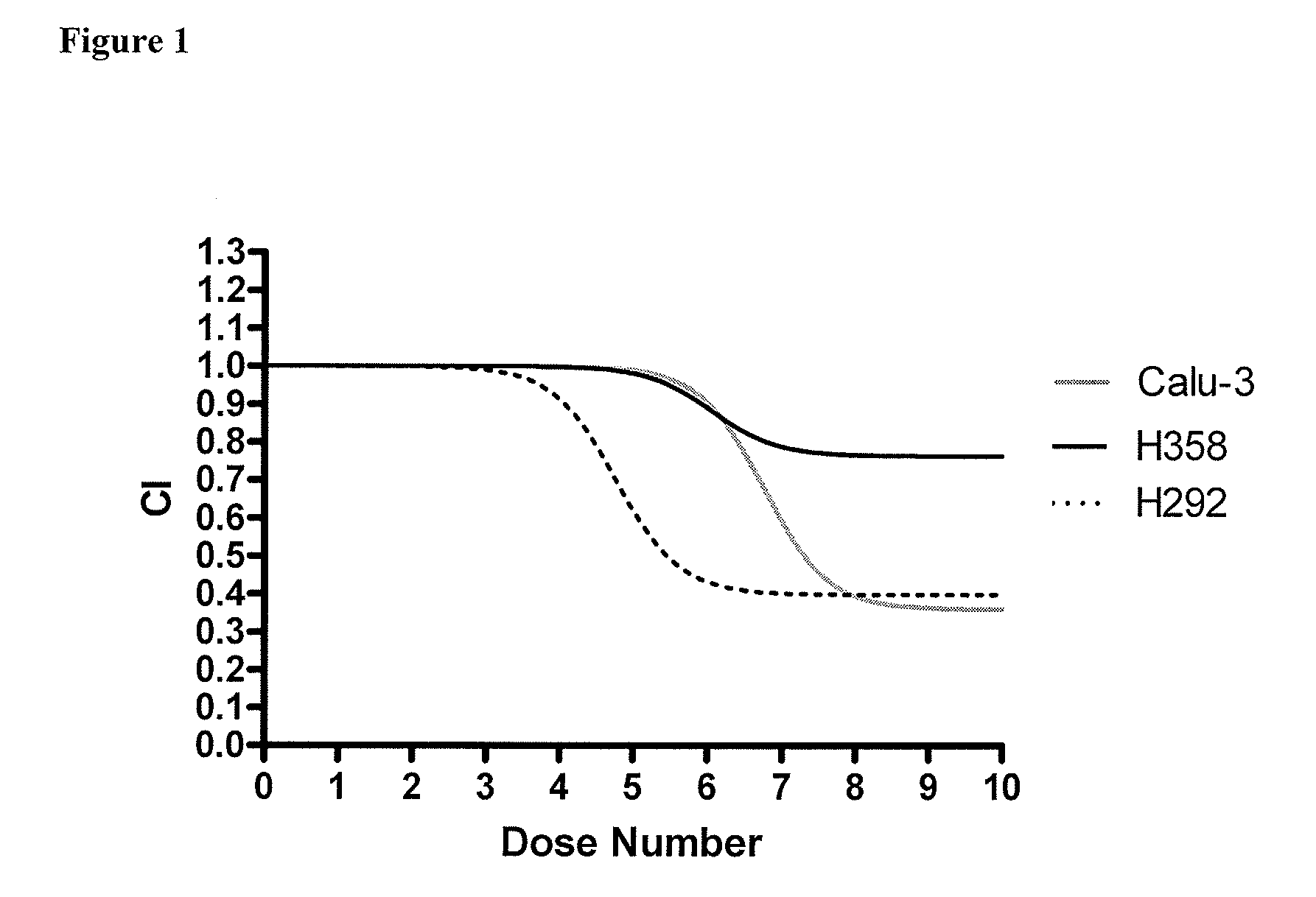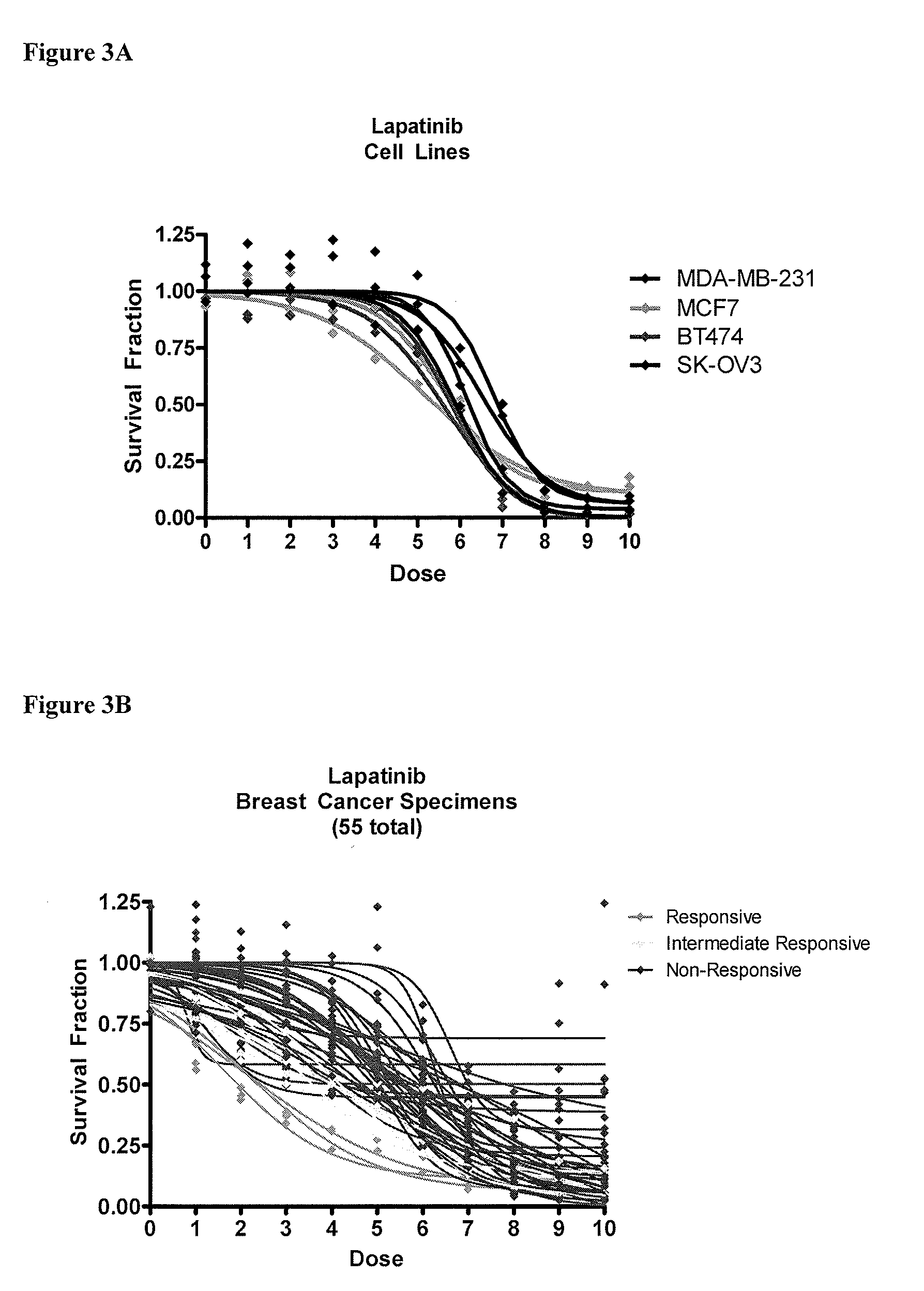Methods for predicting a patient's response to EGFR inhibitors
a technology of egfr inhibitors and patient response, applied in the field of individualizing cancer treatment, can solve the problems of ineffective or non-optimal chemotherapy unnecessary drug toxicity and expense, etc., and achieve the effect of avoiding unnecessary toxicity and expense, low population response rate, and avoiding ineffective treatmen
- Summary
- Abstract
- Description
- Claims
- Application Information
AI Technical Summary
Benefits of technology
Problems solved by technology
Method used
Image
Examples
example 1
[0038]Three human lung tumor-derived immortalized cell lines were tested in this study: H292, H358, and Calu3 (American Type Culture Collection, Manassas, Va.). These cell lines were seeded at 40,000 cells in T25 flasks (PGC Scientifics, Frederick, Md.) and allowed to grow for one week to approximately 90% confluence.
[0039]Patient tumor specimens: Primary cell cultures were established using tumor specimens procured for research purposes from the following sources: National Disease Research Interchange (Philadelphia, Pa.), Cooperative Human Tissue Network (Philadelphia, Pa.), Forbes Regional Hospital (Monroeville, Pa.), Jameson Hospital (New Castle, Pa.), Saint Barnabas Medical Center (Livingston, N.J.), Hamot Medical Center (Erie, Pa.), and Windber Research Institute (Windber, Pa.). The tumors were removed from the patient at the time of surgery, placed in the supplied 125-mL bottle containing sterile McCoy's shipping medium (Mediatech, Herndon, Va.), and shipped overnigh...
example 2
[0050]Lapatinib (Tykerb®) is a small molecule tyrosine kinase inhibitor which targets the intracellular domain of both the epidermal growth factor receptor and Her2, thereby inhibiting cell growth and proliferation. Lapatinib is currently FDA-approved to treat Her2 positive breast cancer which has previously been treated with anthracycline and taxane therapies and trastuzumab. Due to the low population response rate of lapatinib, a biomarker which can identify patients with an increased likelihood for response would be of great clinical utility. This example demonstrates an in vitro chemoresponse assay developed to predict sensitivity and resistance of primary cultures of human breast tumor specimens to lapatinib.
[0051]The chemoresponse assay for lapatinib was developed using four different immortalized cell lines (SK-OV3, BT474, MDA-MB-231, MCF7). In addition to cell lines, the chemoresponse assay was also performed on 55 primary cultures of breast carcinomas. All culture...
example 3
[0054]Cetuximab (Erbitux®) is a chimeric monoclonal antibody that binds to the extracellular domain of the epidermal growth factor receptor. This interaction interferes with binding of the ligand and causes internalization of the receptor which blocks the downstream signaling of EGFR, resulting in impaired cell growth and proliferation. Cetuximab has also been shown to mediate antibody dependent cellular cytotoxicity. Cetuximab is FDA-approved to treat head and neck cancer and colorectal carcinomas; it is also being evaluated in clinical trials for use in other cancers, including non-small cell lung and endometrial cancer. Due to the low population response rate of cetuximab, a test that can identify patients with an increased likelihood for response would be of great clinical utility. The current example demonstrates an in vitro chemoresponse assay to predict response of primary cultures of human colorectal tumor specimens to cetuximab.
[0055]The chemoresponse assay was de...
PUM
 Login to View More
Login to View More Abstract
Description
Claims
Application Information
 Login to View More
Login to View More - R&D
- Intellectual Property
- Life Sciences
- Materials
- Tech Scout
- Unparalleled Data Quality
- Higher Quality Content
- 60% Fewer Hallucinations
Browse by: Latest US Patents, China's latest patents, Technical Efficacy Thesaurus, Application Domain, Technology Topic, Popular Technical Reports.
© 2025 PatSnap. All rights reserved.Legal|Privacy policy|Modern Slavery Act Transparency Statement|Sitemap|About US| Contact US: help@patsnap.com



